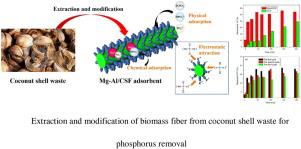Food and Bioproducts Processing ( IF 3.5 ) Pub Date : 2021-01-18 , DOI: 10.1016/j.fbp.2021.01.004 Junjie Yuan , Yao Zhu , Jizhang Wang , Liping Gan , Meiying He , Tao Zhang , Pingping Li , Fengxian Qiu

|
A simple and cheap adsorbent using waste coconut shell fiber (CSF) as the biomass carbon precursor was successfully prepared with the in-situ growth of Mg–Al composite oxide and the resulting Mg–Al/CSF with fractional structure was used for the removal of phosphorus from wastewater. The fractional precipitation of Mg–Al composite oxide on the carbon fiber was achieved by simple immersion method and calcination method. The morphology, composition analysis and specific area of the raw and modified CSF was characterized by SEM, XRD and BET. The maximum adsorption capability of Mg–Al/CSF towards phosphorus was fitted out to be 60.39 mg/g from the Langmuir isotherms model with pH 6, temperature 45 ℃. The phosphorus removal mechanism was verified by the kinetics and thermodynamics results, which was the synergistic combination of surface adsorption and chemical adsorption. In addition, the Mg–Al/CSF adsorbent worked well over the total phosphorus (TP, 0.8–1.1 mg/L) in actual domestic sewage. The results indicated that the prepared Mg–Al/CSF achieved over 50% TP removal in a wide range from 50 to 200 min, which is obviously higher than that of commercial activated carbon. Furthermore, the average TP removal rate of Mg–Al/CSF could reach 46% after recycling for 3 times, which is still much higher than that of commercial activated carbon (28%). The superior recycles results demonstrated the excellent regeneration performance and stability of the prepared sample. The interactions between biomass material with large surface area and metal oxide could be a promising candidate for the other pollutant treatment.
中文翻译:

Mg-Al复合氧化物/椰子壳碳纤维的制备及其在生活污水中有效除磷的应用
利用原位生长Mg-Al复合氧化物成功地制备了一种以废椰子壳纤维(CSF)作为生物质碳前体的简单且便宜的吸附剂,并将所得的具有分级结构的Mg-Al / CSF用于去除水中的金属。废水中的磷。Mg-Al复合氧化物在碳纤维上的沉淀是通过简单的浸没法和煅烧法实现的。通过SEM,XRD和BET对未加工的和改性的CSF的形态,组成分析和比表面积进行了表征。根据pH为6的Langmuir等温模型,温度为45,拟合出Mg–Al / CSF对磷的最大吸附能力为60.39 mg / g。 ℃。通过动力学和热力学结果验证了除磷机理,这是表面吸附和化学吸附的协同结合。此外,Mg-Al / CSF吸附剂 在实际生活污水中的总磷(TP,0.8-1.1 mg / L)方面效果很好。结果表明,制备的Mg-Al / CSF在50至200的宽范围内实现了超过50%的TP去除率 分钟,这显然高于商业活性炭。此外,回收3次后,Mg-Al / CSF的平均TP去除率可达到46%,仍远高于商业活性炭(28%)。优异的回收结果表明所制备样品具有出色的再生性能和稳定性。具有较大表面积的生物质材料与金属氧化物之间的相互作用可能是其他污染物处理的有希望的候选者。











































 京公网安备 11010802027423号
京公网安备 11010802027423号